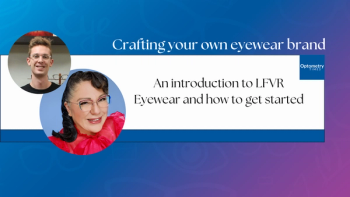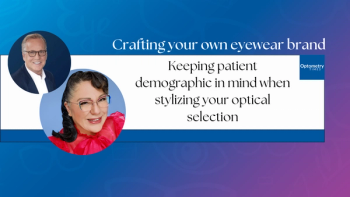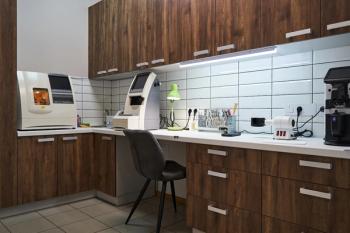
- April digital edition 2022
- Volume 14
- Issue 4
Adopting new technology without sacrificing practice space
Wearable devices and multifunctional instruments provide in-office advantages
When optometrists make important decisions about adding technology to their practice, floor space is often a limiting factor. We seek to equip ourselves to provide patients with the best care possible, and this often involves weighing the effect of various devices on office layout and patient flow.
Eye care professionals need to do what is right for the patient. We build patient trust and we work hard to keep it. If a patient has a condition we cannot confidently diagnose—and we do not have the ability to perform necessary further testing—we will either refer the patient out solely for testing or send them to a specialist for care.
It may then turn out that the problem could have been handled within our office. And that would have saved the patient the hassle of having to travel to a new office and familiarize themselves with new staff.
As the pace of technology development continues to accelerate, more and more devices become available that we could adopt. The good news is that, in general, the size of devices is decreasing.
I have been in the industry for over 25 years and remember training on the first Humphrey Field Analyzer (HFA) by Zeiss, which was 5 feet tall and 5 feet wide, with a big bowl. Though still substantial, current HFA devices are significantly smaller (see Figure 1). Lasers also used to require a large room. Now they are often portable and can be taken from office to office.
The introduction of wearable devices takes this size reduction trend to a new level. In my practice, I use the Heru headset with visual field (see Figure 2), contrast sensitivity, and color vision exams.
The platform is run through a headset that can be hung on the wall. It creates its own dark environment, so no dedicated dark room is needed. This means that adding this powerful technology has no impact on floor space.
Portability upside
The portability of new diagnostic technology, such as the Heru headset with multiple vision diagnostic exams, is incredibly valuable to eye care professionals, as testing can be performed on a patient anywhere within a practice.
As we navigate the COVID-19 pandemic, this gives clinicians the flexibility needed to avoid transporting a patient from room to room. The technology comes to the patient, who can be in a clean room with the door closed.
Another important factor is that the patient is not contaminating an additional testing room. Once a room is contaminated, it is down until it is cleaned. This involves a more thorough, time-consuming clean than the one performed before the arrival of COVID-19, and testing rooms can become bottlenecks.
As practices sought to continue functioning smoothly among new distancing and cleaning requirements, one step was often to take a more problem-focused approach to exams.
Providers would ask whether an exam really needed to be done during the visit or whether it would be possible to skip bringing the patient to a testing room.
At our practice, we also moved equipment around, anticipating the tests patients tended to need at the same time, and trying to put those devices in the same room.
In this environment, the ability to bring instruments into a patient’s exam room is of great value. It makes it easier to carry out a broader range of screening and testing and reduces the need to restrict oneself to a reactive approach.
If the patient has a family history of glaucoma, I can have my technician run a quick visual field using the Heru headset. I can also quickly do an unplanned screening if a patient mentions headaches and I want to rule out neurological factors.
A better use of resources
Waiting rooms often represent underutilized space within a practice. With the introduction of wearables that create their own testing environment, the waiting room can become a testing area. This is also true of the dilation area, which is now sometimes not only a testing station but a treatment area.
In small practices, for example, meibography can be performed in the dilation area. If appropriate for the flow, meibomian gland treatment can also follow in the same location by using either a portable or fixed camera system.
TearCare (Sight Sciences) is a wearable eyelid technology that provides heat therapy, which practitioners can use on patients in the dilation area or exam room (see Figure 3). The manual expression of the meibomian glands can also be done in the exam room by using a slit lamp.
Staff availability is a limited resource in all practices, though it is not related to square footage. Wearables such as the Heru headset free up technicians to carry out valuable activities in the practice while in the room with patient. In the past, a visual field test required a dark room, and the technician was sitting in the dark and could not multitask.
With the Heru headset platform, patients can put on the headset and their environment will be sealed (see Figure 4). The platform features a virtual guide that leads patients through the tests, while real-time gaze tracking within the platform confirms the patient’s fixation is always appropriate.
Patient-driven testing enables the technician to complete other tasks, such as updating records, entering medication into the system, or ordering contact lenses.
While the technician still needs to be in the room, they can still carry out additional activities.
Multifunctionality
Another trend is multifunctionality. A wide variety of diagnostic exams are being combined into 1 device.
Optical coherence tomography (OCT) devices are incorporating cameras, making it possible to capture an image of the retina and the OCT. New OCT devices are also able to make both anterior and posterior segment images, with wide-angle imaging. Further combinations include infrared autorefraction devices that have camera or meibography capabilities.
For glaucoma diagnosis and monitoring, the Ocular Response Analyzer G3 (Reichert) measures both corneal hysteresis and corneal compensated IOP, giving a more complete predictor of glaucoma progression than either IOP alone or IOP together with corneal thickness (see Figure 5 for a similar device). The FAT1 (Falck Medical) measures ocular profusion in addition to IOP, ocular pulse amplitude, and the pulsatile force of the central retinal artery.
Multifunctionality is being combined with wearability. The Heru platform offers suprathreshold and full threshold visual fields, contrast sensitivity testing, and color vision screening (both Ishihara and Farnsworth D-15 extended color vision tests). The company has also just added a new “fast pattern” suprathreshold visual field test that takes only 20 seconds.
When I first began using Heru for visual field testing, I used the platform on a patient with known glaucoma and did an HFA visual field on the same day. This showed me how consistent the results and the printouts were. The digital platform has been shown to have a strong correlation to the gold standard HFA.1
I like the platform’s contrast sensitivity testing capability, because some patients come in who have trouble seeing at night. This usually has to do with lower macular pigment density, which I measure in the palm of the patient’s hand with the Pharmanex BioPhotonic scanner (Figure 6).
This is another device that is able to be moved. I do quite a bit of work with nutraceuticals, so if I have identified a problem with contrast sensitivity and the BioPhotonic scanner, I can start patients on a nutraceutical and then see if their contrast sensitivity and skin carotenoid levels change.
Additionally, lenses now exist that help with color vision problems. I can use the Heru platform for color vision screening to identify patients who might benefit.
These VR platforms are not just for a younger patient population. Heru’s device has been clinically tested on patients between the ages of 15 and 95, and I have found that the tests are so intuitive that just about anyone, at any age, can complete them.
Two of the first patients I tested with the platform, who were in their 60s or 70s, said they thoroughly enjoyed the interactivity.
A promising outlook
The future looks bright for wearables. I envisage a scenario in which the patient arrives in the waiting room and a technician comes out with a wearable diagnostic device, enabling the patient to remain sitting without having to move to an exam room.
A range of screening tests can be performed on the patient to include visual acuities, color vision, pupil assessment, and a quick screening visual field. As these are being uploaded to the system, the technician walks back and does a screening OCT or takes a photo of the patient’s optic nerve.
By the time the technician sits in the room with a patient, they already have an overview of preliminary data that can be shared when the physician enters the exam room.
The faster and more efficient screenings and diagnostics are, the more realistic it is to perform them on patients not demonstrating issues with their vision. Early diagnosis of progressive eye conditions enables optometrists to effectively treat the disease.
Wearable diagnostic platforms and multifunctional devices facilitate a more efficient practice workflow and make it possible for even those with a small space to have an extensive assortment of instruments with increased diagnostic capabilities.
Reference
1. Rethinking glaucoma management using wearable diagnostics from Heru: re:Vive Visual Field. Heru. August 1, 2021. Accessed March 10, 2022. www.seeheru.com/rethinking-glaucoma-management-using-wearable-diagnostics-from-heru-revive-visual-field
Articles in this issue
over 3 years ago
Case report: 16-year-old presents with asymptomatic glaucomaover 3 years ago
When pharmacies threaten treatment plans, look elsewhereover 3 years ago
Dry eye appears in an unlikely subjectover 3 years ago
How $420 co-op dollars netted $19,000 in revenueover 3 years ago
3 practice hacks for success with patientsover 3 years ago
Case report: the “other” AMDover 3 years ago
The ideal LASIK candidateover 3 years ago
Contact lens disinfection methods still matterNewsletter
Want more insights like this? Subscribe to Optometry Times and get clinical pearls and practice tips delivered straight to your inbox.
















































.png)


